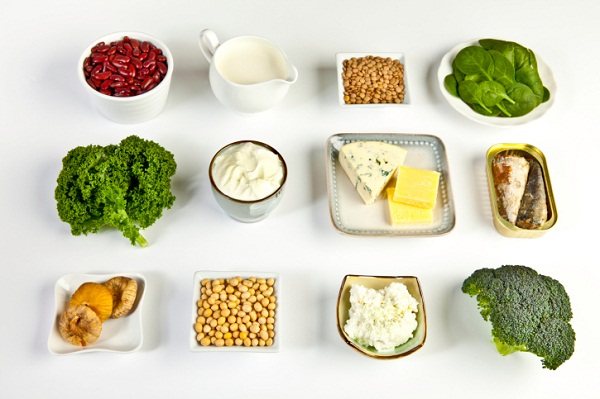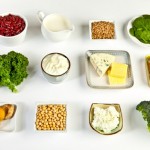Whether you are vegan or just milk not part of your regular diet, you should know that there are other ways to add calcium to your diet, a mineral of great importance for the organism.
The calcium is a nutrient that not only needs our bones and teeth but also is key to the nervous system, heart, and muscular system, therefore, if you do not consume dairy products, here are some options for calcium not miss in your table:
Seafood, a simple way to add calcium
The fish and shellfish are a good alternative to add this mineral to our dishes, but also are a simple way to include the nutrient to the table if we are not vegans, of course.
Blue fish are most concentrated calcium, some of the specimens with the highest proportion, the sardine, especially in oil, horse mackerel, the cod or tuna.
Among shellfish and crustaceans, noted for its calcium content the squid, the clams and cockles, the octopus, the oysters and prawns exceeding 100 mg of calcium per 100 grams.

In addition, these foods often contain vitamin D, a nutrient that enhances the absorption of calcium and therefore its intake guarantee a better use of mineral in our body.
Nuts and seeds, another calcium-rich alternative
If this option is appropriate for vegans and can help to add calcium in significant quantities if we consume every day just over 50 grams of nuts or seeds.
Among the units that concentrate greater proportion of calcium are the poppy seeds and sesame, the sunflower, the almonds, the hazelnuts, the dried figs and dried tomatoes.
Of course, all derivatives of these ingredients are also good sources of nondairy, such as calcium tahini based sesame.
The tahini is a creamy emulsion is obtained from the milling of sesame seeds with vegetable oils. Although still not used so extended, it is well known as salsa, especially among vegetarians, who represents a good source of iron and calcium.
Besides being a heart – healthy food for its richness in unsaturated fatty acids, tahini provides for every 2 tablespoons (about 30 grams), about 130 mg of calcium and about 2.5 mg of iron, amounts exceeding the contribution of these minerals in milk and meat vaccine respectively.
This sauce can be used to spread some toast, to flavor salads, hummus to develop or to add texture, aroma and flavor to many other dishes, besides being a good source of iron and calcium of plant origin.
Legumes, nutritious way to add calcium
The legumes, not only a good source of fiber, vegetable protein and B vitamins, but also are another way to add calcium to the diet.
With legumes such as soybeans, we can incorporate up to 200 mg of calcium if you eat 100 grams of it. In addition, they noted for their content in this mineral the beans, chickpeas and beans and to a lesser extent, beans, lentils, and peas.
As expected derivatives, legumes also concentrate calcium, for example, tempeh resulting from the fermentation of soybeans and are widely used among vegans. Do little more than 100 mg of calcium per 100 grams, and an amount that represents 10% of the daily quota.
Vegetables and algae are also a source of calcium
Although not the most concentrated calcium alternatives, some vegetables, and algae can help us meet the needs of this important mineral for the body.
Algae are mostly rich in calcium, although the seaweed wakened and kelp is the most concentrated in these nutrient choices, followed by agar especially in their dried form.
Vegetables, more options calcium are cabbages, such as curly cabbage, broccoli or Brussels sprouts. Also are good sources of calcium the spinach, the turnip, the rhubarb, the watercress, and chard.
Herbs and spices, small ingredients that can add calcium
A final alternative for those who do not consume dairy and want to add more calcium to your diet is to use certain herbs and spices that can help add the mineral, even used in small proportions.
For example, the cinnamon, the laurel, the pepper, the dill, and parsley are good sources of calcium and can add just a small scoop about 50 to 60 mg of the mineral.
The thyme, rosemary or dried oregano can also provide calcium in amounts that reach the proportion of the mineral in a glass of milk with only two small spoonfuls.
As we can see, if you do not eat dairy, you have many different ways to add calcium to the diet and prevent its deficit in the body. It is only important to know where to find the ore and the vitamin D that can be found in different foods greatly favors their use in our body.
Ensuring the inclusion of calcium in our dishes to benefit health
The calcium is one of the most abundant minerals in our body and its functions become highly relevant inclusion in the diet daily. So today we aim to put collaborate giving some tips to ensure the inclusion of calcium in our dishes and benefits health with a proper supply of this element.
The importance of calcium for health
The calcium in the human body is 99% as salts, forming part of bones and teeth and the remaining 1% found in body fluids. Their functions in the body make it important inclusion in the supply to meet the needs of this mineral, as well as participating in the formation and maintenance of bones and teeth, calcium is involved in many metabolic processes.
Among the most important functions of calcium found the formation of structures, their involvement in blood clotting, their participation in the transport of cell membrane that allows input of nutrients through this mineral and also calcium is involved in the transmission of nerve impulses and in muscle contraction. Therefore, the operation of the heart and other organs and skeletal muscles depends on the concentration of calcium and other ions.
During the various stages of life, calcium must be present, especially during periods of increased growth and development to ensure proper bone formation and dental.
The ingests recommended calcium from 500 mg in children under 4 years up to 1200 mg per day in adulthood.
Calcium recommendations for age
The calcium is one of the most abundant in the body and most important minerals due to their involvement in the formation of bones and teeth, in the nervous system and muscle contraction. So keep an adequate intake of calcium is essential and for that, nothing better than knowing the recommendations by age and biological stage.
Then you will see how it changes the recommended intake calcium as we grow, to accompany the body’s own changes and encouraging:
- In infants, 7 to 12 months recommended calcium intake is 270 mg per day.
- In children between 1 and 3 years are recommended 500 mg daily.
- In children between 4 and 8 years are recommended 800 mg per day.
- In children between 9 and 13 years, old are recommended 1300 mg per day.
- In adolescents between 14 and 18 are recommended 1300 mg per day.
- In adults between 19 and 50 years, recommendation for calcium is 1000 mg per day.
- In adults, over 51 years are recommended 1200 mg daily
- In pregnancy and lactation, the recommended intake is more than 1200 mg per day.
Knowing what the recommended daily intake of calcium will guide us about their consumption as adolescent intake calcium-rich foods should increase towards children and likewise if our age exceeds 51 years.
Remember that foods rich in calcium are dairy in general, sardines, soy, legumes, hazelnuts, almonds and vegetables such as broccoli, watercress or others.
The use of calcium by the body
The calcium is a mineral found mainly in foods dairy, with a higher content of cheeses and yogurts and milk lower in. There are also many nondairy foods, which can offer calcium, for example, fish such as sardines or mackerel, especially when eaten with its skeleton.
In the plant kingdom, some foods have a higher proportion of calcium, for example, verdures greens such as chard, borage, and spinach, also legumes and nuts, however, the presence of certain substances returns to the milk and its derivatives the main source of calcium that can greatly benefit the human body.
In dairy, the presence of calcium by the content of vitamin D in these foods and lactose, calcium makes these better absorbed in the body. In addition, to these two factors calcium in an acid medium, it is better absorbed so that fruits with dairy products can improve the utilization of mineral.
There are also factors that inhibit the absorption of calcium in the body and they are above all the plant foods, such as oxalic acid found in spinach, chocolate, cocoa and sugar beet; the phytic acid and fiber mainly present in whole grains and phosphorus that can return insoluble calcium and limit its use to the body.
On the other hand, there are some dietary factors that incremental calcium excretion in urine and, therefore, decrease their concentrations in the human body. For example high intake of protein and sodium that increase calcium loss in the urine, excessive consumption of tea, coffee or mate containing xanthones that produce the same effect as well as the habit of smoking or drinking alcohol in large quantities.
Therefore, in addition to limiting, the latter habits to reduce their loss should include products with high content of calcium and combine them with those who favor its absorption, especially when calcium is not derived from dairy and we must compensate with facilitators’ absorption those inhibitors.
Tips include calcium in our food and health benefit
- Make sauces and dressings made from milk or other dairy products, such as béchamel, volute sauce or other based on these.
- Include cheese to our salads and / or seeds, sesame seeds, poppy, flax or other that are high in calcium in small amounts.
- Use milk in place of water to cook your cereal, for example, cornmeal cooked in milk, cous hydrated in milk, noodles, and semolina cooked in milk or oatmeal. Milk can also be used as a basis for a cream soup or a dessert. For example, rice pudding, curd strawberry, creamy lemon dessert, custards, puddings or other.
- In savory dishes, combining vegetable greens with cheese or milk rich in vitamin D may promote absorption of calcium in spinach, watercress, chard or other. Healthy dishes with this combination are for example spinach soup, rolls spinach and feta cheese, cannelloni with spinach and pine nuts, pastry spinach and cheese, watercress salad and goat cheese, among others.
- Add spices or herbs rich in calcium when seasoning dishes, for example parsley, basil, saffron.
- Employ fish whose spines are preserved and, therefore, are rich in calcium, for example, three in one sardine, cheese, anchovy and jam, snacks anchovy, skewer mackerel with tomato and, among others.
- Use pulses combined with milk and vegetables, to promote absorption of calcium from the first with vitamin D and lactose of the milk derivatives and the acid environment that can give fruits and vegetables.
Taking into account what factors facilitate the use of calcium in the body and which foods we can find this mineral, we cannot fail to apply the advice given to ensure the presence of calcium in our plates and provide health benefits to cover the share of this element so important in the human body.


